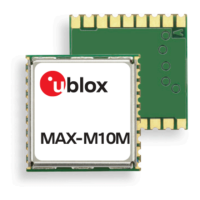MAX-M10M-Integration manual
3.6.2.6 Configuration
Power save mode (PSM) is enabled and disabled with CFG-PM-OPERATEMODE and configured with
items in the CFG-PM group listed in Table 22.
When using power save mode on/off (PSMOO) operation, set the OPERATEMODE as the last
PSM configuration key to prevent the receiver entering the off state before all intended PSM
configuration keys are set.
Config key Description
OPERATEMODE Receiver mode of operation
POSUPDATEPERIOD Time between two position fix attempts in on/off power save mode
ACQPERIOD Time between two acquisition attempts if the receiver is unable to get a position fix
GRIDOFFSET Time offset of update grid with respect to start of week
ONTIME Time the receiver remains in the "Tracking" state and produces position fixes
MINACQTIME Minimum time the receiver spends in the "Acquisition" state
MAXACQTIME Maximum time in the "Acquisition" state
DONOTENTEROFF Receiver does not enter the "Inactive for search" state if it cannot get a position fix but
keeps indefinitely attempting a position fix instead
WAITTIMEFIX Wait for time fix before entering the "Tracking" state
UPDATEEPH Enables periodic ephemeris update
EXTINTWAKE Enables EXTINT pin control to force receiver on
EXTINTBACKUP Enables EXTINT pin control to force receiver in backup
EXTINTINACTIVE Enter a backup state if EXTINT pin is inactive longer time than specified by
EXTINTINACTIVITY
EXTINTINACTIVITY Specifies the inactivity period
Table 22: Power save mode configuration options in the CFG-PM group
OPERATEMODE The mode of operation to use mainly depends on the update period: For short
update periods (in the range of a few seconds), cyclic tracking should be configured. For long update
periods (in the range of minutes or longer), only use on/off operation. See section On/Off mode and
Cyclic tracking for more information on the two modes of operation.
POSUPDATEPERIOD, ACQPERIOD The update period POSUPDATEPERIOD specifies the time
between successive position fixes. If no position fix can be obtained within the acquisition timeout,
the receiver will retry after the time specified by the search period ACQPERIOD. Update and search
periods are fixed with respect to an absolute time grid based on reference time standard (i.e., GPS
time or UTC). They do not refer to the time of the last valid position fix or last position fix attempt.
Where multiple GNSS can operate simultaneously, UTC time is used as the reference time standard.
The update period setting is ignored if the receiver is set into cyclic tracking mode. It only has an
impact if the receiver is set to on/off mode. New settings are ignored if the update period or the
search period exceeds the maximum number of milliseconds in a week. In that case the previously
stored values remain effective.
GRIDOFFSET Once the receiver has a valid time, the update grid is aligned to the start of the week of
the reference time standard (midnight between Saturday and Sunday). Before having a valid time,
the update grid is unaligned. A grid offset shifts the update grid with respect to the start of the week
of the reference time standard. The grid offset is not used in cyclic tracking operation.
ONTIME This specifies how long the receiver stays in the "Tracking" state before switching to the
"POT" state in PSMCT or the "Inactive for update" state in PSMOO.
UBX-22038241 - R02
3 Receiver functionality Page 40 of 92
C1-Public

